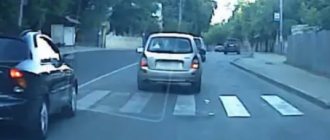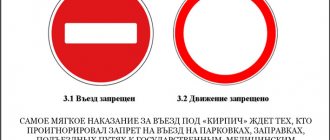What types of red markings are there, and for what purposes?
The types and rules for applying road markings in the Russian Federation are regulated by the Rules of the Road, which are approved by Government Decree No. 1090 and GOST 51256-2018.
In accordance with these documents, road markings can be:
- Depending on location:
- horizontal stripes, which are applied directly to the road surface
- vertical stripes applied to road barriers, poles, roadside elements, etc.
- Depending on the purpose:
- constant, valid regardless of the time of year, days of the week and other circumstances
- temporary, applied only for a certain period of time, for example, spring-autumn thaw or for the duration of repair work
The main colors of road markings are white and yellow. However, in real life you can also see red markings.
Red lines are drawn:
- as a temporary marking if the traffic service does not have orange. In this situation, the marking lines must be duplicated by the corresponding road signs
- to indicate the most dangerous sections of the road, which allows you to attract the attention of drivers. Markings can mark places where stopping or parking is prohibited, speed limits, and so on.
- to designate dedicated lanes that are intended for the movement of route transport. The solid line should be duplicated by the letter “A”
- to mark the boundaries of an intersection
- to designate a pedestrian crossing area. Red marking lines alternate with standard white lines. Such crossings are constructed on particularly dangerous sections of the road or when a large number of people with disabilities pass through (for example, near hospitals, hospices, etc.)
- to highlight bicycle paths and intersections of bicycle paths with the roadway. Red marking means that motor vehicles, which include road transport, are prohibited from crossing the specified borders
- to highlight pedestrian zones located along the roadway, for example, in the absence of curbs and sidewalks. Cars are also prohibited from crossing the continuous marking line.
- to designate sections of the roadway approaching a pedestrian crossing. As a rule, marking lines are applied to the road, located across the roadway. Glass beads are added to the paint to further attract the attention of drivers with a sound effect. In most cases, additional markings with a noise effect are applied to the road on dangerous sections of the road, as well as near schools, kindergartens and other educational institutions, hospitals, buildings with large crowds of people (shopping centers, cinemas, etc.)
- to highlight dangerous sections of the road or sharp turns, separating lanes in opposite directions. Vertical markings are applied to poles installed along the roadway.
Red red road markings: myth or reality
Red road markings are applied in Russia when carrying out repair or construction work. Accordingly, its lifetime does not exceed the duration of these operations. Essentially, this is a temporary marking. In European countries it is done in yellow or orange. Such bright colors were not chosen by chance. The driver must see that the permanent markings are not currently valid. Most drivers are accustomed to seeing white markings on the roads. And when they come across a traffic control device that has a different shade, there may be some delays in decision making. Yes, yes, road markings can be not only white!
Related traffic signs
Red markings are usually used in conjunction with duplicate signs. The following must be installed in appropriate locations:
- signs indicating the approach or boundaries of a pedestrian crossing
- “Children” sign (installed in nearby places, kindergartens, schools and other child care institutions)
- The “Bicycle path” sign is installed in places where there are separate lanes for cyclists and where bicycle paths intersect with the roadway
- the “Road Works” sign is used to warn drivers about repair work and the presence of temporary markings
- signs prohibiting stopping or parking
- signs limiting the speed of movement on this section of the road
- signs warning of approaching dangerous turns
- sign warning of other danger
Road markings of the Russian Federation
— separates traffic flows of opposite or similar directions on sections of roads where changing lanes is allowed only from one lane; indicates places where it is necessary to allow movement only from the side of the broken line (at places of turn, entry and exit from the adjacent territory); - (color - yellow) - designates a section of the intersection that is prohibited from entering if there is a traffic jam ahead along the route that will force the driver to stop, creating an obstacle to the movement of vehicles in the transverse direction, with the exception of turning right or left in the cases established by these Rules. The marking can be used independently or in conjunction with road sign 1.35.
21 Dec 2021 marketur 160
Share this post
- Related Posts
- Does a group 2 disabled person hide the fact that he is disabled to his employer?
- How many days does it take for alcohol to be completely removed from the body?
- I live on one pension of 10,000 rubles. Am I entitled to a subsidy for housing and communal services?
- Housing Code of the Russian Federation 2021, is it possible to contribute fees for cleaning entrances to the maintenance of housing?
What to do if the markings are erased
Situations often arise in which the markings on the road are not visible (they have been erased over time, covered with snow, etc.), what to do?
When maneuvering in this situation, you must be guided by the road signs installed along the roadway, which duplicate the marking lines, and, in their absence, the traffic rules.
It is important to know that:
- If there are lanes for vehicle traffic, you can cross broken marking lines to overtake or get ahead.
- If there are more than four lanes on the road, there must be a double solid marking line demarcating the directions.
- U-turn is prohibited:
- at pedestrian crossings
- in the tunnels
- on overpasses and overpasses
- at railway crossings
- on sections of the roadway with a visibility zone of less than 100 m
- The maximum speed in a populated area is 60 km/h, and outside it – 90 km/h. The exception is highways and other sections of the road marked with signs;
- Overtaking is prohibited:
- at signalized intersections and at uncontrolled intersections when driving on a secondary road
- at pedestrian crossings
- on dangerous sections of the road and in areas with limited visibility (up to 100 m)
- in tunnels, bridges, overpasses and overpasses
- at railway crossings and 100 m before them
- Stopping and parking are prohibited:
- on the tram tracks
- at railway crossings and 50 m before them
- on bridges, overpasses, overpasses and under them
- in the tunnels
- at pedestrian crossings and 5 m before them
- at intersections and 5 m before them
- on dangerous sections of the road with visibility less than 100 m
- in any areas when creating interference for other traffic participants
- at public transport and minibus stops (except for boarding and disembarking passengers)
What does an orange solid stripe on the road mean?
When markings have stroke lengths half as long as the gaps, overtaking vehicles is permitted. The corresponding sign and intermittent yellow markings on the road mean that parking in such areas is prohibited, but stopping or unloading is allowed. The line may be present at the very edge of the road, painted on the curb. Such markings on suburban sections of roads prohibit stopping in the marked area, and violation of the rule will be regarded as driving on the side of the road.
- White markings are permanent and are applied in most cases to mark the edge of the roadway and divide the roadway into stripes. It can be intermittent or continuous, and also mark a pedestrian crossing or serve as a stop line before a traffic light, crossing or pedestrian crossing.
- The orange markings are temporary.
We recommend reading: When is Father's Day in Russia in December 2021?
Amounts of fines
Violation of the rules established by the marking lines is an administrative offense.
Liability in the form of a fine or deprivation of rights is provided for the following types of violations:
- For exceeding the established speed limit (Article 12.9 of the Administrative Code):
- for an amount of 20 km/h – 40 km/h – a fine of 500 rubles
- for 40 – 60 km/h – 1,500 rubles
- for the amount of 60 – 80 km/h – 2,000 – 2,500 rubles or deprivation of rights for 4-6 months
- for more than 80 km/h – 5,000 rubles or deprivation of rights for 6 months
- Stopping and parking at a railway crossing (Article 12.10 of the Administrative Code) – 1,000 rubles or deprivation of a driver’s license for 3-6 months.
- Driving to an intersection when there is a traffic jam (Article 12.13 of the Administrative Code) - a fine of 1,000 rubles.
- Turning around in a prohibited place (Article 12.14 of the Administrative Code) - a fine of 500 rubles.
- Driving on bicycle or pedestrian paths (Article 12.15 of the Code of Administrative Offenses) - fine 2,000 rubles.
- Driving into a lane intended for public transport (Article 12.15 of the Administrative Code) - a fine of 1,000-1,500 rubles.
- Drifting into oncoming traffic or tram tracks (Article 12.15 of the Code of Administrative Offences) – a fine of 5,000 rubles or deprivation of rights for 4-6 months.
- Failure to comply with the requirements established by markings regarding stopping and parking (Article 12.16 of the Administrative Code) - a fine of 1,500 rubles (for regions of the Russian Federation) or 3,000 rubles (for Moscow and St. Petersburg).
- Failure to provide an advantage to pedestrians at a pedestrian crossing (Article 12.18 of the Code of Administrative Offenses) - fine 1,500-2,500 rubles.
Other color markings on the road
In accordance with GOST 51256-2018, other colors can be used for road markings:
- white. The priority color used for most permanent marking lines
- orange, primarily used for temporary markings
- yellow. Used to designate sections of the roadway where, for one reason or another, it is prohibited to perform such maneuvers as parking and stopping. Yellow lines also indicate stops for public transport (passenger taxis) and the boundaries of intersections (“waffle irons”)
- blue. Used to delimit the boundaries of traffic lanes, for example, at an intersection
- green. The primary area of use is duplication of installed road signs on the roadway
What do the red markings on the bicycle road before the bus stop mean?
If a minibus leaves the route, for example, to avoid a traffic jam, it loses the right not to follow these signs. We quote the Russian Federation Traffic Regulations: 3. Prohibition signs Signs do not apply: 3.1 - 3.3, 3.18.1, 3.18.2, 3.19, 3.27 - to route vehicles; Here we are talking about the following road signs: 4. Mandatory signs The validity of signs 4.1.1 - 4.1.6 does not apply to route vehicles.
In the coverage area of marking 1.17 in combination with the signs “Bus and (or) trolleybus stopping place” (5.16) and “Tram stopping place” (5.17), it is prohibited: firstly, to make a U-turn and reverse; secondly, to stopping and parking of vehicles (as well as at a distance of 15 meters before and after the marking site).











